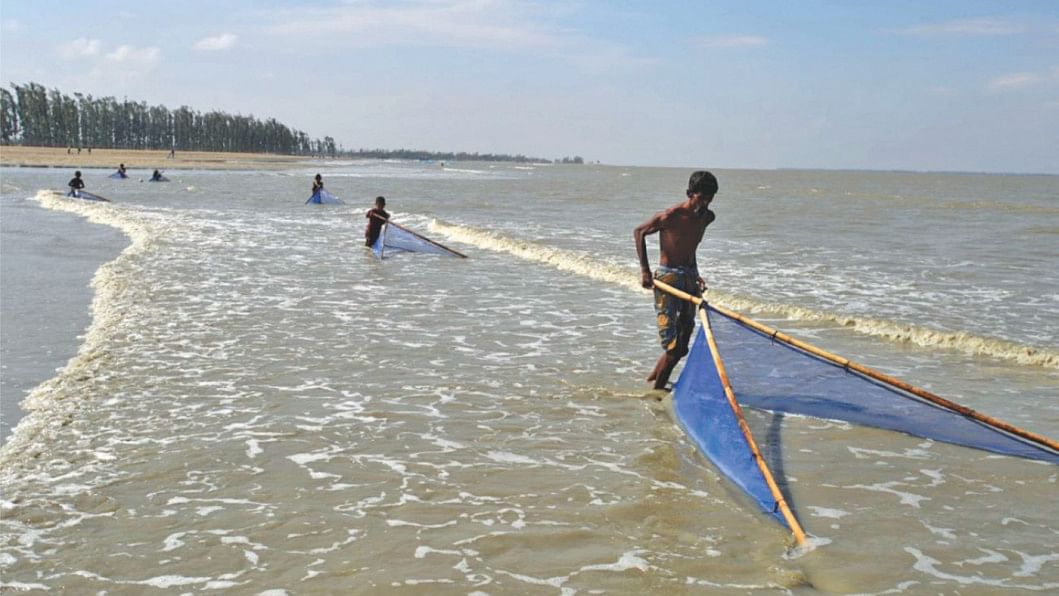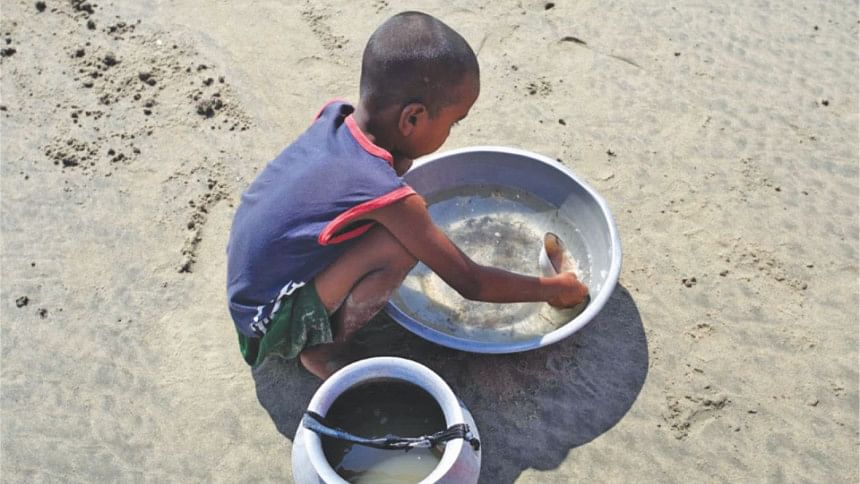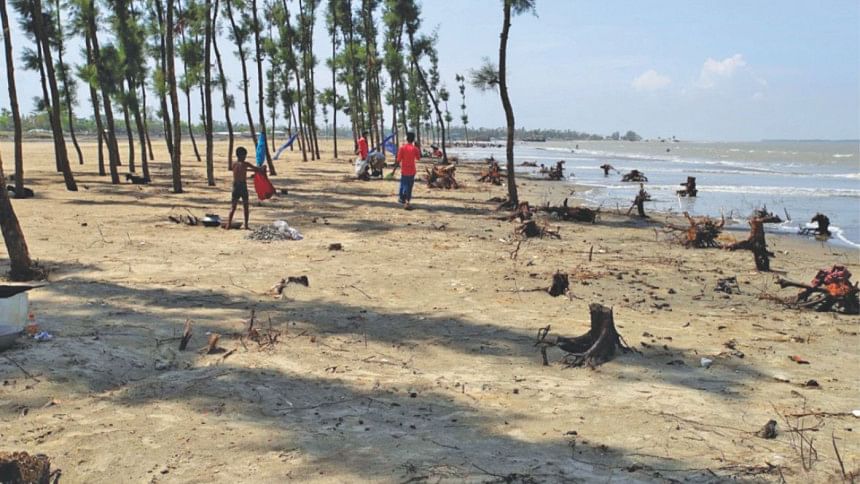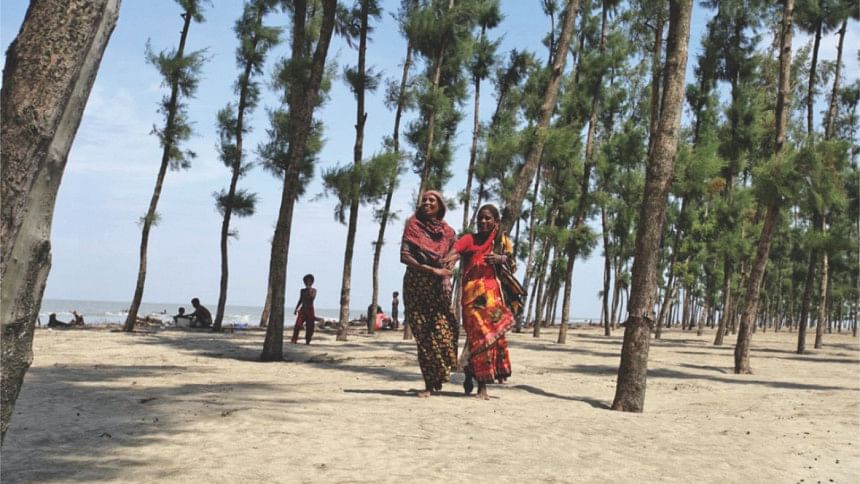The last days of an ecology

When we made our way to the intra-division bus terminal in Chittagong city, it was just after dawn. At the counter, there was a small line of people looking to book their tickets early. At the front of the queue, the person behind the counter kept yawning midway through sorting out tickets. “Gondamara union, Banshkhali”, I said.
He adjusted himself in his seat. “Gondamara? Okhane to manush ke martese.” (They're killing people there).
It was an ominous start to a long trip towards the westernmost part of the Chittagong division, Gondamara union in Banskhali upazila. Over time it became clear that Gondamara union was not only incredibly disconnected from the rest of the upazila and the greater Chittagong area, it was also one of the most vulnerable places in the country to cyclones and tidal flooding. When hurricanes formed in the Bay of Bengal make their way towards the land, a frequented route is right through Gondamara union. When cyclone Sidr hit the coast, Gondamara union suffered the heaviest damage in terms of flooding, deaths and destruction of crops and houses. While Sidr was a very large cyclone formation—one of the largest to hit Bangladesh—even weaker cyclonic winds have caused extensive damage to the area. On May 20, 2016, cyclone Roanu made landfall and Gondamara became one of the worst hit areas in the country. The storm caused embankments to flood and destroyed roads, houses and salt farms in the area. It has been estimated that several million taka worth of salt and fish were damaged by the cyclone.

The residents of Gondamara, however, were going through a crisis long before the cyclone had struck. The Chinese firm SEPCOI, in partnership with S. Alam Group, had been given permission to build two coal-fired power plants right at the cusp of the Bay of Bengal, in Gondamara union. On December 19, 2013, the Bangladeshi conglomerate S. Alam group signed an agreement with SEPCOII Electric Power Construction Corporation of China to set up coal-fired power plants in Chittagong with a capacity of 1320 megawatts. Afterwards, S. Alam began identifying possible areas for the construction of the power plants before finally deciding on Gondamara union in Banshkhali as the final location for their power plants. S. Alam group purchased 655 acres of land on the coast of Gondamara for the two 660 megawatt power plants.
On April 4, 2016 Banshkhali witnessed the worst tragedy in a coal-related protest since the protests in Jharkhand, India in 2012. Four protesters were killed as police and cadres met the protesters with bullets and tear gas (The Daily Star, April 5, 2016). Locals allege many wrongdoings in the way S. Alam acquired the land. Their main objections include falsehood while purchasing the land, not paying the entire amount promised and, above all, not letting the locals know until much later that the land was for a coal-fired power plant. They point to their shrimp hatcheries, their large fishing projects and their salt farms and logically claim that all of these practices stand to be negatively impacted by the coal plant. Over time, the claims were repeated with growing resignation as Gondamara union slowly became the new frontier of state-sanctioned corporate exploitation. Media coverage of the issue has been truly indicative of the corporate loyalties and disappearing ethics of large newspapers and television stations. But even when there has been coverage, the true extent of the potential ramifications of the power plant has been overlooked.
Understanding people as ecology
We spent a few days in Gondamara after the protests had begun as part of an archiving mission for Center For Bangladesh Studies (CBS). Over time, it became evident that there were two Gondamaras, figuratively speaking. There was a Gondamara to the east and a Gondamara to the West, both sides divided by the embankment that cyclone Roanu had destroyed. Most of the media coverage remained restricted to the east where the landed gentry and Liakat Ali, the BNP politician, resided.
On the other side of the broken dam, the reality was entirely different. It took us quite a while to traverse through the mud and broken paths of what was once the barrier that separated the large, lucrative fishing projects from the sea water. We were essentially crossing over to the area where the power plant was being constructed, although the storm and the protests had momentarily halted the construction. There, we encountered men, women and children all busy wading through the waves. They were catching small shrimp hatchlings and small fish that swam up to the shore. On the coast, there was a large canopy of tamarisk (jhau) trees which formed the last barrier to winds and tidal surges coming towards Gondamara. We could still see the places where the trees had been uprooted by the wind. The locals said they cleared the area from uprooted trees after the storm, which had cleaned up most of the damage.

The dynamics of this coastal population were strikingly different from the residents further inland. Women, children and men all carried out their work next to each other. They rested, chatted and ate their lunch under the shade of the trees before going back to work. They supplied the hatchlings to traders inland who then supplied it to large shrimp farms. They spent their lives next to the ocean and were in sync with every transition of a wave. Their fishing of crabs, shrimp and small fish is all done by manual tools, which makes sure there isn't overfishing, or overpopulation of one species. Put simply, they formed an integral part of the coastal ecology, they kept it safe and clean, they survived on it and in many ways, it survived on them.
More than any cyclone ever could, the power plant in Gondamara poses a major threat to the balanced ecology of the region and to all its inhabitants. Conventional coal-fired power plants, which make water boil to generate steam that activates a turbine, have an efficiency of about 32 percent. Supercritical (SC) and ultra-supercritical (USC) power plants operate at temperatures and pressures above the critical point of water, i.e. above the temperature and pressure at which the liquid and gas phases of water coexist in equilibrium, at which point there is no difference between water gas and liquid water. This results in higher efficiencies—above 45 percent. Supercritical (SC) and ultra -supercritical (USC) power plants require less coal per megawatt-hour, leading to lower emissions (including carbon dioxide and mercury), higher efficiency and lower fuel costs per megawatt.
Globally, the average efficiency of coal-fired generation is 33 percent HHV (higher heating value) basis or 35 percent LHV (lower heating value) basis. In a survey of countries worldwide, the average three-year (2009–2011) efficiency of coal-fired electric generating fleets ranged from a low of 26 percent in India to a high of 41 percent in France. It is difficult to estimate the exact percentage of energy that would be effectively used by SS Power Ltd without knowing the kind of coal to be imported and the types of technologies to be used both in the pre and post-heating process. The only relevant bit of information provided by S. Alam in this case has been that to mitigate pollution, the project will construct a 90-storey chimney system, according to Abdul Hanna, assistant manager of the project.
Regardless of the kind of technology and coal to be utilised, there are certain solid and non-solid emissions that will take place due to the operations of the power plant. These include, but are not limited to: (i) Sulfur dioxide, which causes acid rain, damages crops, forests, and soils, and acidifies lakes and streams. A typical coal plant with emissions controls, including flue gas desulfurisation (smokestack scrubbers), emits 7,000 tons of SO2 per year; (ii) nitrous oxides, which causes ground level ozone, or smog, which can burn lung tissue, exacerbate asthma, and make people more susceptible to chronic respiratory diseases. A typical coal plant with emissions controls, including selective catalytic reduction technology, emits 3,300 tons of NOx per year; (iii) mercury, a toxic heavy metal that causes brain damage and heart problems. Just 1/70th of a teaspoon of mercury deposited on a 25-acre lake can make the fish unsafe to eat' (iv) carbon dioxide, which is the leading contributor of greenhouse gases; (v) fly ash, which can cause chronic bronchitis, aggravated asthma, and premature death, as well as haze obstructing visibility. Other discharges may include lead, arsenic and carbon monoxide.
In coal power plants with once-through cooling systems, once the 70 to 180 billion gallons of water have cycled through the power plant (for a typical 600-megawatt plant), they are released back into the lake, river, or ocean. This water is hotter (by up to 20-25° F) than the water with which it is mixed, creating "thermal pollution" that can decrease fertility and increase heart rates in fish.

All of this is by now common knowledge to those who have been campaigning so long against the Rampal coal power plant near the Sundarbans. There has not been a word about in months about Banshkhali. The story goes that Sundarbans protects us from cyclones; it is a national heritage and its beauty is unparalleled. We must not let it be destroyed. It seems more important to protest Rampal than Banshkhali, perhaps because the centre (urban, middle-class) has more to lose in the former than the latter. With the Sundarbans, we lose a national heritage with which we feel a sense of belonging—that beautiful place in our pictures and our textbooks.
Mariam, a fisherwoman, invited us to her house and made a meal for us. She kept smiling as she spoke about her children, her own work and the rebuilding after the storm. She spoke of the ocean with a sense of familiarity and respect that I could not understand. She spoke of the power plant with fierce anger and pain. Her mother-in-law and sister sat next to her as she entertained her guests. From the other side of the room, the kids peered in. Mariam handed them a couple of biscuits.
By 2020, when the power plant is operational, it is likely that Mariam and her family will no longer be in the west of Gondamara. It is also likely that the complex and sustainable ecology that we saw will no longer exist. It is unlikely that such beautiful ecologies will be able to survive the country's aggressive development agenda. Is that not important enough for a protest?
The writer is a research fellow at Centre for Bangladesh Studies (CBS).





Comments